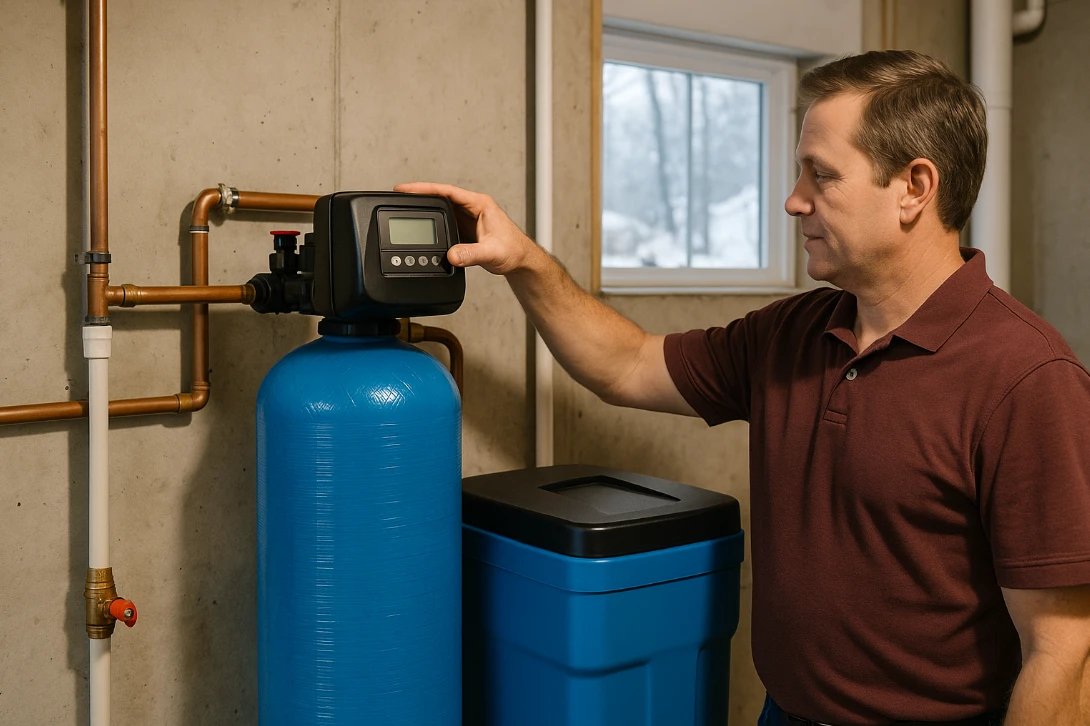Each Canadian household is challenged in a different way by water, including chlorine byproducts in the municipal water supply of Vancouver and the limestone belt of Ontario that contains hard minerals. All types attack particular contaminants, so that you end up with dirt-free and good-tasting water, no matter where you are, or in your high-rise condos in Toronto.

1. Water Softeners
In Canada, 85 percent of homes are affected by hard water that is rich in calcium and magnesium. To substitute these minerals with sodium or potassium, water softeners replace these minerals with ion exchange resin. This is to avoid the formation of a scale on pipes, kettles, and water heaters.
- Best for: Limescale on faucets, dry skin after showers, and high energy bills.
- Result: Softer laundry, longer appliance life (up to 30% longer). Superior Water Purification installs high-efficiency water purification systems with demand-initiated regeneration, which saves water.
2. Reverse Osmosis (RO) Systems
Reverse osmosis is the most suitable in the event of dissolved solids such as lead, arsenic, nitrates, or PFAS. The water is pushed to the semi-permeable membrane that rejects 95 to 99 percent of the contaminants and offers bottled-quality water out of your tap.
- Best for: Heavy metals, nitrates in farming areas, “forever chemicals.”
- Result: Crystal-clear, neutral-tasting water that is ideal for drinking, cooking, and baby formula. You can choose from under-sink or whole-house RO options, which include remineralization stages to restore healthy minerals.
3. Whole-House Water Filtration Systems
These point-of-entry systems treat all the water entering your home. They remove sediment, chlorine, chloramines, and odors before the water reaches any tap.
- Best for: Chlorine taste in city water, rust from old pipes, sulfur smells in well water.
- Result: Fresher showers, better-tasting food, and protected plumbing throughout the house. Multi-stage carbon and sediment filters provide thorough protection without wasting water.
4. UV Disinfection Systems
Without the use of chemicals, ultraviolet light instantly kills bacteria, viruses, and parasites such as E. coli or Giardia. Critical in rural households, cottages, or regions that are under boil-water warnings.
- Best for: Rural properties with independent water sources, lakeside cabins, and areas with frequent water advisories.
- Result: 99.99% pathogen kill rate, safety, and chemical-free. Use a pre-filter to filter sediment and increase the bulb life (1-year replacement).
5. Activated Carbon Block Filters
Chlorine, VOCs (volatile organic compounds), pesticides, and herbicides are adsorbed onto carbon blocks (granular or solid), and the taste and odor are enhanced.
- Best for: Municipal water that contains chemical aftertaste, pesticide runoff in the area around farmlands.
- Result: Cleaner ice cubes, better coffee, reduced exposure to disinfection byproducts. Compact under-sink units or full-flow cartridges fit any budget. — Taste & Chemical Removal
6. Iron & Manganese Removal Systems
Specialty media such as Birm or Katalox is used on reddish-brown iron stains and black manganese specks.
- Best for: in stained sinks, metallic taste, and clogged pipes.
- Result: crystal-clear water, no additional laundry stains, secured fixtures. The maintenance of the system is light because it is automatically backwashed.
7. Combo Systems (Hybrid Solutions)
Why choose one when you can have all? Superior Water Purification designs hybrid systems combining softeners, RO, carbon, and UV for total protection.
- Best for: Homes with multiple issues (e.g., hard well water + bacteria + chlorine).
- Result: One integrated solution, centralized control, maximum purity. Rental plans include full maintenance—perfect for busy families or businesses.
How to Pick the Right System for You
- Start with a Free Water Test – Superior Water Purification visits your home, tests for 20+ parameters, and maps results to Health Canada standards.
- Match Contaminants to Technology – Hardness? Softener. Bacteria? UV. Lead? RO.
For example, a young family purchased their first house in a small town in Southern Ontario. Asthmatic to get rid of bottled water, they set up a simple big-box water softener that serves a two-person house. In half a year, the scale covered their new kettle like barnacles, and dishes emerged hazy, and their toddler had worse eczema than ever. Their four-person reality was smaller than the size of the system and could not manage the hardness of the area, which was 400mg/L or more. The use of salt increased three times, the brine tank overflowed, and the resin bed was iron-clogged. Free re-test done by Superior Water Purification showed the incorrect match; they switched to a correctly sized demand-initiated softener. Spots disappeared, skin was better, and the system is now consuming 60 per cent less salt--evidence that the right fit would make frustration flow.
Conclusion
More than 85 percent of homes in Canada have some type of water quality problem--but 100 percent of them can be remedied. It may be the hard minerals of a limestone bedrock, or it may be the chlorine of a metropolis treatment, or it may be the bacteria of a country well, but in any case, the answer is the same: know, then act. It is possible to match these results with the appropriate technology, such as softeners, RO, UV, or hybrid systems, to ensure that all drops are safe, clean, and refreshing. Health isn't the only thing being benefited: the longevity of appliances, the skin being softer, the food it produces being better tasting, the energy and bottled water savings that will be realized.







